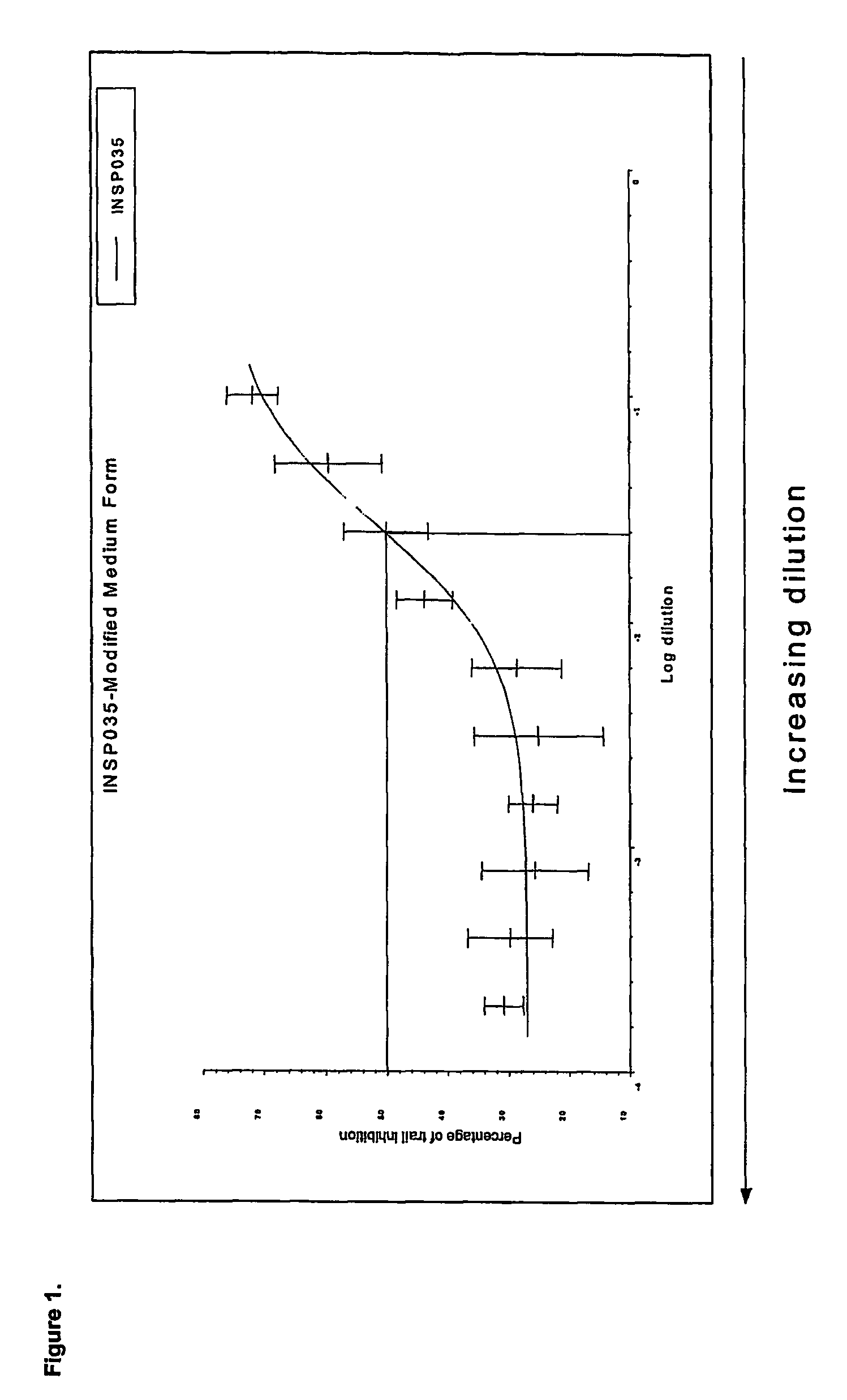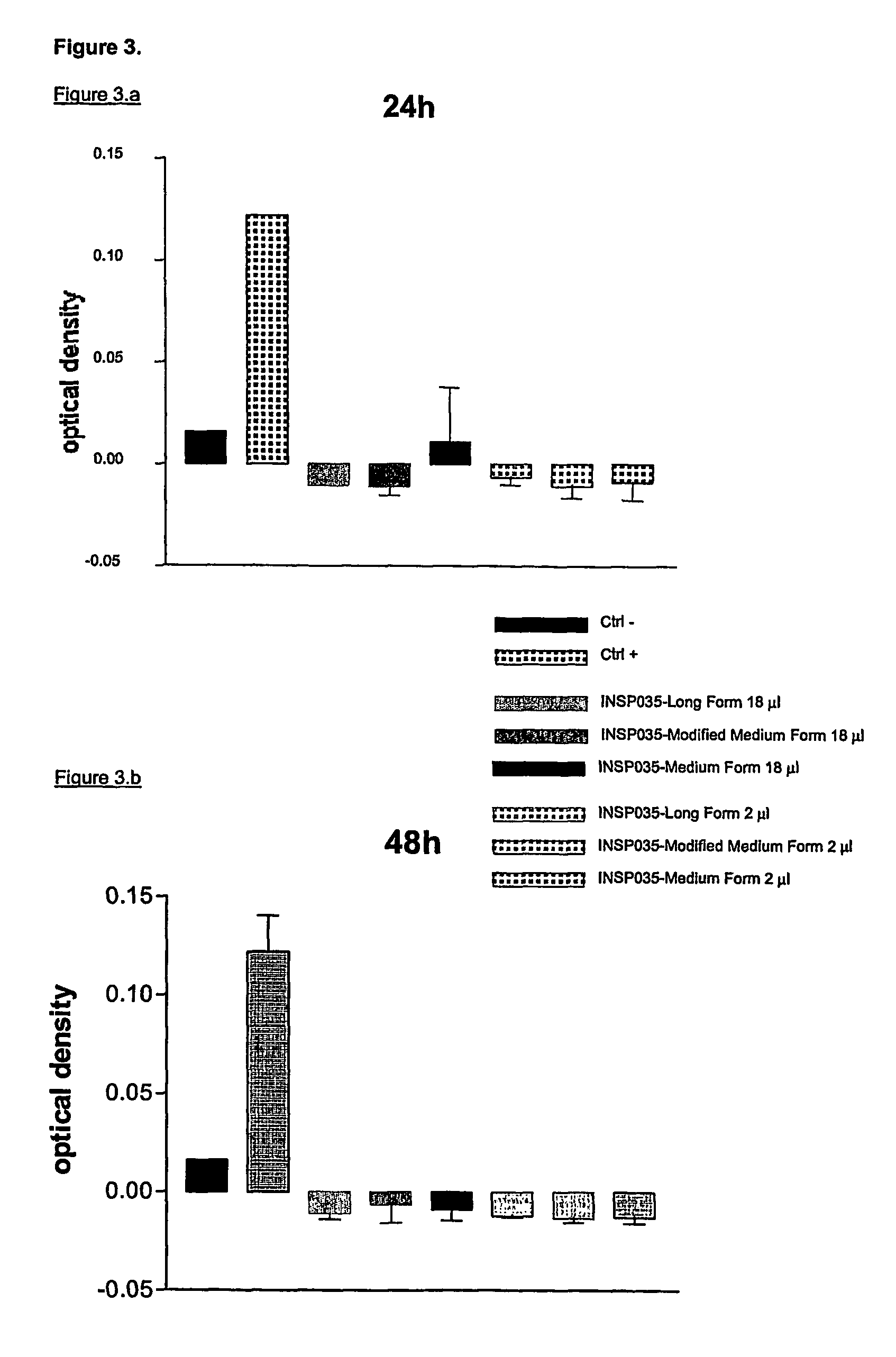Treatment of fibrotic disease
a fibrotic disease and fibroblast technology, applied in the field of fibroblast disease treatment, can solve the problems of increased collagen synthesis, scarring, bile flow, etc., and achieve the effect of reducing the apoptosis of fibroblasts
- Summary
- Abstract
- Description
- Claims
- Application Information
AI Technical Summary
Benefits of technology
Problems solved by technology
Method used
Image
Examples
example 1
Cloning and Expression
[0123]Cloning of INSP035, construction of plasmids for expression of INSP035 in HEK293 / EBNA cells, Identification of cDNA libraries / templates containing INSP035 and the expression of INSP035-Long-6HIS-V1 in mammalian cells are described in Example 1 and Example 2 of WO03 / 054012.
example 2
INSP035's Neutralization of Apoptosis in Fibroblasts Treated with Soluble Human Recombinant TRAIL
2.1 Introduction
[0124]TNF-related apoptosis-inducing ligand (TRAIL) has been shown to be one of the cellular ligands for osteoprotegerin (OPG). A secondary assay mimicking this physiological interaction in fibroblasts was developed. This assay, neutralization of apoptosis in fibroblasts treated with soluble human recombinant TRAIL, is indicated to select potentially novel TRAIL receptors and novel proteins and small molecules with anti-apoptotic activity.
2.2 Equipments and Softwares
[0125]96 Well tissue culture plate (ref costar no 3596)[0126]96 plate reader with 490 nm filter[0127]Graph Pad Prism software
2.3 Materials and Reagents[0128]L929 mouse fibroblast cells (CCL-1)[0129](American Type culture collection ATCC)[0130]DMEM (32430-027) Gibco BRL[0131]Sterile fetal bovine serum[0132]Actinomycin D (FLUKA ref 01817)[0133]Recombinant Human Trail / TNFS10[0134]Cytotox 96 Non radioactive (Prome...
example 3
Generation of an E. coli Expression Construct for INSP035
[0145]A Gateway™ cloning system compatible plasmid, pENTR-INSP035-6HIS was mutated by site-directed mutagenesis, in order to insert a Shine-Dalgarno sequence (5′ AAGGAGATG) upstream of the initiating codon of the INSP035 cDNA. The resultant mutated plasmid was then subjected to a recombination reaction with the E. coli expression vector pDEST14 to create pDEST14-SD-INSP035-6HIS.
3. Insertion of a Shine—Dalgamo Sequence into pENTR-INSP035-6HIS by Site-directed mutagenesis
3.1 Gene Specific Cloning Primers for Site-directed Mutagenesis
[0146]A pair of PCR primers, INSP035-MF and INSP035-MR (Table 4), were designed such that the primers annealed to opposite strands of the plasmid pENTR-INSP035-6HIS sequence and each primer annealed to 15 -25 bases on either side of the region to be inserted. The PCR primers were optimised to have a Tm greater than or equal to 78° C., a minimum GC content of 40%, and either a G or a C as the 3′ termi...
PUM
| Property | Measurement | Unit |
|---|---|---|
| concentrations | aaaaa | aaaaa |
| concentrations | aaaaa | aaaaa |
| concentrations | aaaaa | aaaaa |
Abstract
Description
Claims
Application Information
 Login to View More
Login to View More - R&D
- Intellectual Property
- Life Sciences
- Materials
- Tech Scout
- Unparalleled Data Quality
- Higher Quality Content
- 60% Fewer Hallucinations
Browse by: Latest US Patents, China's latest patents, Technical Efficacy Thesaurus, Application Domain, Technology Topic, Popular Technical Reports.
© 2025 PatSnap. All rights reserved.Legal|Privacy policy|Modern Slavery Act Transparency Statement|Sitemap|About US| Contact US: help@patsnap.com



